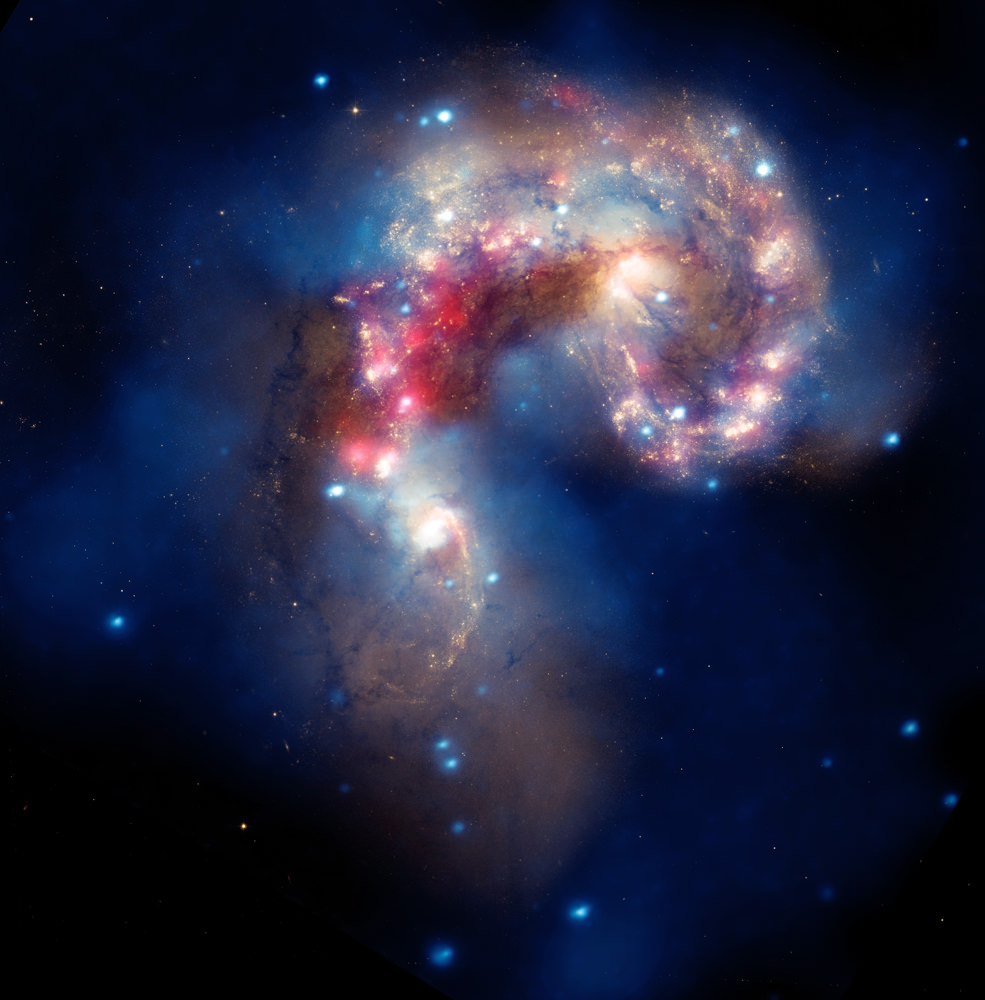[/caption]
A new image of two tangled galaxies has been released by NASA’s Great Observatories. The Antennae galaxies, located about 62 million light-years from Earth, are shown in this composite image from the Chandra X-ray Observatory (blue), the Hubble Space Telescope (gold and brown), and the Spitzer Space Telescope (red). The Antennae galaxies take their name from the long, antenna-like arms seen in wide-angle views of the system. These features were produced in the collision.
The collision, which began more than 100 million years ago and is still occurring, has triggered the formation of millions of stars in clouds of dusts and gas in the galaxies. The most massive of these young stars have already sped through their evolution in a few million years and exploded as supernovas.
The X-ray image from Chandra shows huge clouds of hot, interstellar gas, which have been injected with rich deposits of elements from supernova explosions. This enriched gas, which includes elements such as oxygen, iron, magnesium and silicon, will be incorporated into new generations of stars and planets. The bright, point-like sources in the image are produced by material falling onto black holes and neutron stars that are remnants of the massive stars. Some of these black holes may have masses that are almost one hundred times that of the sun.
The Spitzer data show infrared light from warm dust clouds that have been heated by newborn stars, with the brightest clouds lying in the overlap region between the two galaxies. The Hubble data reveal old stars and star-forming regions in gold and white, while filaments of dust appear in brown. Many of the fainter objects in the optical image are clusters containing thousands of stars.


Whoa, amazing! Being able to see many wavelengths at the same time shows so much more than visible light alone!
Absolutely stunning image! I like!
The Antenna galaxies are found in Corvus, below Virgo near 12h, -18deg (R.A. 12h 01m 53.0s / 12h 01m 53.6s, Dec -18° 52? 10? / -18° 53? 11? magnitude 10.9). and is best viewed in the springtime sky.
Draw a ‘line’ between Delta and Gamma Corvi and travel about the same distance as that separation, and you are there! The central core of this pair can be glimpsed In a 6″ telescope, while a good 12″ or larger is needed to reveal any details. Good hunting!
As stunning as it is, I would also like to see a “side-by-side” collection of the pictures in the different wavelengths. The pic above appears quite packed to me, and I cannot identify too many new details, which would be much easier when the pictures are available for their own….
Btw: Impressive picture 😉
Should be re-named the “Jumbo Shrimp” Galaxy. Yummm.
@ DrFlimmer:
Where would you be without me? 😉 Ask and you shall receive:
X-ray, Infrared, & Optical Images of the Antennae galaxies (Hint: click on the thumbnail images there).
@ Ivan3man
Still here, I guess ;). Anyway, thanks a lot 🙂
Sorry for the double post, but on a second thought my previous answer is not entirely correct. I would still be on this planet, that’s true, because Ivan3man had obviously nothing to do with that (at least, not that I would know) 😀 .
But without him, I wouldn’t visit this page.
Btw: Did I mention this already? Nice picture! 😉
According to Standard Gravity and Special Relat theories, these colliding galaxies have approx 90% dark matter mass in order for gravity to retain their 4% mass of visible matter spiral antennae galactic shapes. Their new observational shape is seen in the photo by including x-rays, radio, IR regions, clearly indicating ionic hot charged gas particles for plasma physics likely through warm hot intergalactic medium filaments containg oxygen ions that stretch across thousands of galaxies central black holes, as reverifed recently by Fang looking along the line of sight of a large nearby black hole sees 2 billion long filaments at 2 million degrees kelvin. Fang says this may connect all large cosmological structures in the universe, and if so, there is no reason for dark matter to play a role in colliding galaxies that are 99% hydrogen and helium.